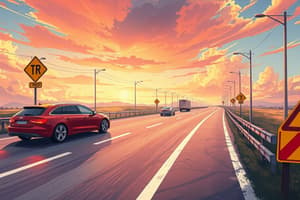Podcast
Questions and Answers
What should you do if you need to drive through a flooded road?
What should you do if you need to drive through a flooded road?
- Take a detour to avoid the flooded road
- Speed up to get through it quickly
- Drive slowly and test your brakes after crossing (correct)
- Try to determine the depth of the flood before crossing
What is a danger of driving on flooded roads?
What is a danger of driving on flooded roads?
- Tire blowout
- Fuel leak
- Vehicle malfunction (correct)
- Overheating engine
Why should you not use cruise control while driving in high winds?
Why should you not use cruise control while driving in high winds?
- It can cause your vehicle to speed up
- It can cause your vehicle to lose control
- It can reduce your reaction time to gusts of wind (correct)
- It can increase your fuel consumption
What should you do to maintain control of your vehicle while driving in high winds?
What should you do to maintain control of your vehicle while driving in high winds?
What should you do if you encounter a flooded road and there is no other route?
What should you do if you encounter a flooded road and there is no other route?
What should you do when driving in heavy fog or smoke?
What should you do when driving in heavy fog or smoke?
Why do law enforcement officers use traffic breaks during heavy fog or unusual traffic conditions?
Why do law enforcement officers use traffic breaks during heavy fog or unusual traffic conditions?
What should you do when you encounter a traffic break?
What should you do when you encounter a traffic break?
What is a precaution to take when driving in heavy fog or smoke?
What is a precaution to take when driving in heavy fog or smoke?
What should you do if you cannot drive safely in heavy fog or smoke?
What should you do if you cannot drive safely in heavy fog or smoke?
What is the maximum speed you should drive if you can only see 100 feet ahead?
What is the maximum speed you should drive if you can only see 100 feet ahead?
What should you do if you hear sloshing sounds from your tires while driving in wet conditions?
What should you do if you hear sloshing sounds from your tires while driving in wet conditions?
If your vehicle becomes stuck in the snow or mud, what should you avoid doing?
If your vehicle becomes stuck in the snow or mud, what should you avoid doing?
What should you carry when driving in snowy areas?
What should you carry when driving in snowy areas?
If you start to hydroplane, what should you do?
If you start to hydroplane, what should you do?
What should you do when another driver is using high-beam headlights?
What should you do when another driver is using high-beam headlights?
What is a common hazard when driving at night?
What is a common hazard when driving at night?
What can help you manage sun glare while driving?
What can help you manage sun glare while driving?
What should you do when you leave a brightly lit place and start driving at night?
What should you do when you leave a brightly lit place and start driving at night?
What can cause your vehicle to skid on the road?
What can cause your vehicle to skid on the road?
Flashcards are hidden until you start studying
Study Notes
Safe Driving in Adverse Conditions
- Drive no faster than 30 mph if you cannot see farther than 100 feet.
- In snowy areas, carry snow chains for your tires to increase traction.
- In wet or rainy conditions, hydroplaning can occur when tires lose contact with the road.
Hydroplaning
- Avoid hydroplaning by driving slowly, steering around standing water, and slowing down when hearing sloshing sounds from tires.
- If hydroplaning occurs, slow down gradually and do not use the brakes.
Stuck in Snow or Mud
- To get unstuck, shift into a low gear, keep the front wheels straight, and gently step on the accelerator.
- Drive slowly forward, then shift into reverse and slowly back up, repeating the process until the vehicle rolls free.
- If necessary, place boards or tree branches under the tires to gain traction.
Flooded Roads
- Excessive water on a road can cause flooding, making it difficult to determine the depth.
- Be aware of the dangers of water on the road, including being swept away, floating debris, and vehicle malfunction.
- If driving through a flooded road, drive slowly and test your brakes afterward.
High Winds
- Reduce speed when driving in high winds to maintain control over your vehicle.
- Maintain a firm hand position on the steering wheel and be alert for debris on the road.
- Avoid using cruise control and be proactive in pulling over if necessary.
Fog or Heavy Smoke
- Drive slowly and use low-beam headlights when driving in heavy fog or smoke.
- Make sure you can stop within the space you can see ahead and increase your following distance.
- Avoid crossing lanes or passing traffic unless absolutely necessary.
Law Enforcement Traffic Breaks
- If an officer initiates a traffic break, turn on your emergency flashers and slow down to the same speed as the officer.
- Keep a safe distance from the patrol vehicle and do not drive past it.
Night Driving
- Use low-beam headlights when it is raining.
- Be aware of pedestrians, bicyclists, and motorcycles, which are harder to see at night.
- Reduce your speed in highway construction zones at night.
Sun Glare
- Keep your windshield clean and wear polarized sunglasses to manage sun glare.
- Maintain enough space between your vehicle and others, and be aware of pedestrians.
Skids
- A skid occurs when one or more tires lose traction with the road.
- Drive slowly and leave space between your vehicle and the vehicle ahead to avoid slippery surface skids.
Studying That Suits You
Use AI to generate personalized quizzes and flashcards to suit your learning preferences.




